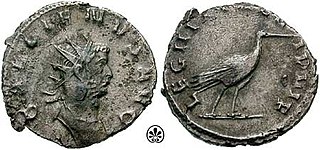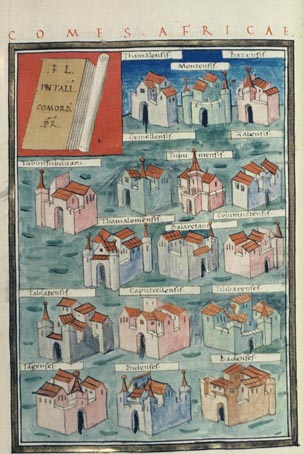

The Cornuti ("horned") was an auxilia palatina unit of the Late Roman army, active in the 4th and 5th century. It was probably related to the Cornuti seniores and the Cornuti iuniores.


The Cornuti ("horned") was an auxilia palatina unit of the Late Roman army, active in the 4th and 5th century. It was probably related to the Cornuti seniores and the Cornuti iuniores.
According to some scholars, they are depicted on the Arch of Constantine, as the soldiers who are shown wearing horned helmets. On the relief representing the Battle of Verona (312) they are in the first lines, and they are depicted fighting with the bowmen in the relief of the Battle of the Milvian Bridge. [1]
The Cornuti belonged to the comitatus of Gaul, and is attested on the northern border since 355. In 357 it was led by the tribunus Bainobaudes in an attack against the Alemanni who had attacked the Roman territory and had later retired on a small island.
In that same year, the Cornuti fought the Alemanni in the Battle of Argentoratum, under the command of the emperor Julian. When the Alamannic cavalry caused the Roman equites to flee, the Cornuti and its twin unit, the Brachiati , held the enemy horsemen until Julian rallied the Roman cavalry and brought them back in battle. Despite the Romans being victorious, Bainobaudes, the tribune of the Cornuti was killed.
The Cornuti and the Brachiati were famous for their barritus , a combination of shout and dance step. [2]
The Notitia Dignitatum , a document describing civil and military offices in the Western Roman Empire around 420 and in the Eastern Roman Empire in 395 circa, records the existence of the Cornuti seniores under the command of the magister peditum praesentalis of the West. [3] The same source records the existence of the Cornuti iuniores, who fought in the Battle of Adrianople (378) and later part the army of the magister militum praesentalis of the East. [4] Later the Cornuti iuniores were sent to guard the Porta Aurea of Constantinople together with the Leones iuniores , as testified by an inscription date to 413. [5]

Legio III Italica was a legion of the Imperial Roman army founded in 165 AD by the emperor Marcus Aurelius for his campaign against the Marcomanni tribe. The cognomen Italica suggests that the legion's original recruits were drawn for the defence of Italy. The legion was still active in Raetia and other provinces in the early 5th century.

The Notitia dignitatum et administrationum omnium tam civilium quam militarium is a document of the Late Roman Empire that details the administrative organization of the Western and the Eastern Roman Empire. It is unique as one of very few surviving documents of Roman government, and describes several thousand offices from the imperial court to provincial governments, diplomatic missions, and army units. It is usually considered to be accurate for the Western Roman Empire in the 420s AD and for the Eastern or Byzantine Empire in the 390s AD. However, the text itself is not dated, and omissions complicate ascertaining its date from its content.

The Jovians and Herculians were the senior palatine imperial guard units under the rule of Roman Emperor Diocletian. They continued in existence thereafter as senior units in the field armies of the Western and Eastern Roman Empires.

Dux Britanniarum was a military post in Roman Britain, probably created by Emperor Diocletian or Constantine I during the late third or early fourth century. The Dux (literally, " leader" was a senior officer in the late Roman army of the West in Britain. It is listed in the Notitia Dignitatum as being one of the three commands in Britain, along with the Comes Britanniarum and Count of the Saxon Shore.
Auxilia palatina were infantry units of the Late Roman army, first raised by Constantine I as part of the new field army he created in about 325 AD.
The Battle of Strasbourg, also known as the Battle of Argentoratum, was fought in 357 between the Western Roman army under the Caesar Julian and the Alamanni tribal confederation led by the joint paramount King Chnodomar. The battle took place near Strasbourg, called Argentoratum in Ammianus Marcellinus' account, Argentorate in the Tabula Peutingeriana.
Laeti, the plural form of laetus, was a term used in the late Roman Empire to denote communities of barbari ("barbarians"), i.e. foreigners, or people from outside the Empire, permitted to settle on, and granted land in, imperial territory on condition that they provide recruits for the Roman military. The term laetus is of uncertain origin. It means "lucky" or "happy" in Latin, but may derive from a non-Latin word. It may derive from a Germanic word meaning "serf" or "half-free colonist". Other authorities suggest the term was of Celtic or Iranian origin.

The Scholae Palatinae were an elite military imperial guard unit, usually ascribed to the Roman Emperor Constantine the Great as a replacement for the equites singulares Augusti, the cavalry arm of the Praetorian Guard. The Scholae survived in Roman and later Byzantine service until they disappeared from the historical record in the late 11th century, during the reign of Alexios I Komnenos.

Petulantes was an auxilia palatina of the Late Roman army.

The Taifals or Tayfals were a people group of Germanic or Sarmatian origin, first documented north of the lower Danube in the mid third century AD. They experienced an unsettled and fragmented history, for the most part in association with various Gothic peoples, and alternately fighting against or for the Romans. In the late fourth century some Taifali were settled within the Roman Empire, notably in western Gaul in the modern province of Poitou. They subsequently supplied mounted units to the Roman army and continued to be a significant source of cavalry for early Merovingian armies. By the sixth century their region of western Gaul had acquired a distinct identity as Thifalia.

In modern scholarship, the "late" period of the Roman army begins with the accession of the Emperor Diocletian in AD 284, and ends in 480 with the death of Julius Nepos, being roughly coterminous with the Dominate. During the period 395–476, the army of the Roman Empire's western half progressively disintegrated, while its counterpart in the East, known as the East Roman army remained largely intact in size and structure until the reign of Justinian I.

The Eastern Roman army refers to the army of the eastern section of the Roman Empire, from the empire's definitive split in 395 AD to the army's reorganization by themes after the permanent loss of Syria, Palestine and Egypt to the Arabs in the 7th century during the Byzantine-Arab Wars. The East Roman army was the continuation of the Late Roman army of the 4th century, until it gradually transformed into what is now called the Byzantine army from the 7th century onwards.
The palatini were elite units of the Late Roman army mostly attached to the comitatus praesentales, or imperial escort armies. In the elaborate hierarchy of troop-grades, the palatini ranked below the scholares, but above the comitatenses and the limitanei.

Equites cataphractarii, or simply cataphractarii, were the most heavily armoured type of Roman cavalry in the Imperial Roman army and Late Roman army. The term derives from a Greek word, κατάφρακτος kataphraktos, meaning "covered over" or "completely covered".

The comes Africae was in the Late Roman Empire, the commander of the troops comitatenses and limitanei in the diocese of Africa. His direct superiors were, in times of the Notitia dignitatum, about 400, the magister peditum for the units of infantry and the magister equitum for those of cavalry. He also supervised the performance of the dux limitis Mauretaniae Caesariensis and the dux provinciae Tripolitanae.

The Batavi was an auxilia palatina (infantry) unit of the late Roman army, active between the 4th and the 5th century. It was composed by 500 soldiers and was the heir of those ethnic groups that were initially used as auxiliary units of the Roman army and later integrated in the Roman Empire after the Constitutio Antoniniana. Their name was derived from the people of the Batavi.

The Heruli was an auxilia palatina unit of the Late Roman army, active between the 4th and the 5th century. It was composed of 500 soldiers and was the heir of those ethnic groups that were initially used as auxiliary units of the Roman army and later integrated in the Roman Empire after the Constitutio Antoniniana. Their name was derived from the people of the Heruli. In the sources they are usually recorded together with the Batavi, and it is probable the two units fought together. At the beginning of the 5th century two related units are attested, the Heruli seniores in the West and the Heruli iuniores in the East.

The Primani was a legio palatina of the Late Roman army, active in the 4th and 5th century.

The Regii or Reges was a Germanic auxilia palatina unit of the Late Roman army, active between the 4th and the 5th century. There was also a legio comitatensis with the same name. The Regii had its main period of action in the mid-4th century when they were recruited to fight against the Alamannic incursions and invasions of the Roman Empire. Most likely the Regii themselves were composed of Alamannic or Suebi recruits, and were recruited for their extensive knowledge and familiarity with the Suebic Alamanni and their allies.

The equites stablesiani were a class of cavalry in the Late Roman army. They were one of several categories of cavalry unit or vexillatio created between the 260s and 290s as part of a reorganization and expansion of Roman cavalry forces initiated during the reign of Gallienus. These new cavalry vexillationes typically shared the basic regimental designation equites, and included equites Dalmatae, equites Mauri and equites scutarii.